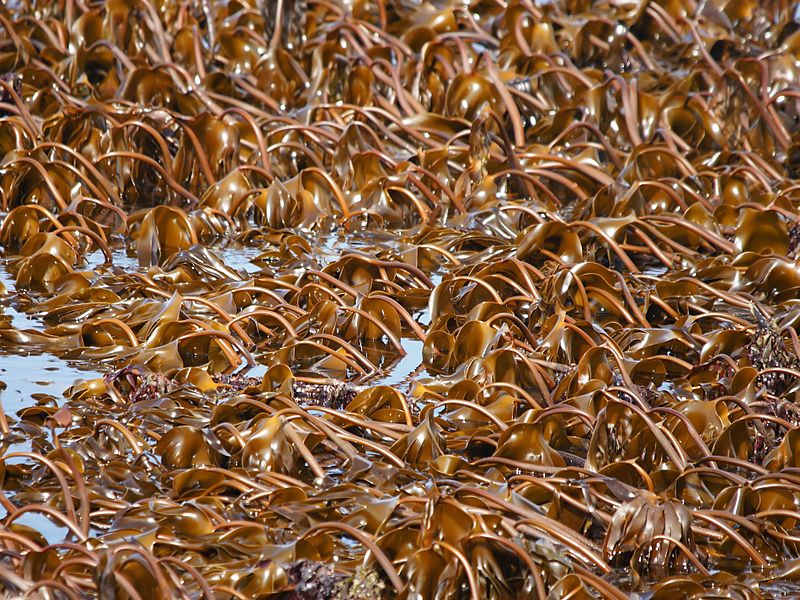Taxonomy
Kingdom: Chromista
Subkingdom: Harosa
Infrakingdom: Heterokonta
Phylum: Ochrophyta
Subphylum: Phaeista
Infraphylum: Limnista
Superclass: Fucistia
Class: Phaeophyceae
Order: Laminariales
Family:Laminariaceae
Genus: Laminaria
Similar species: Ecklonia, Macrocystis, Saccorhiza polyschides
Previously known as: Gigantea Stackhouse, Hafgygia Kützing

Biological Information/Life History
| Growth Rate | Varies greatly (Smale et al. 2013) |
| Size at maturity | 1-3 m (Petruzzello 2016) |
| Life span | 1-18 years (Smale et al. 2013) |
| Mating/spawning season | Varies |
| Sessile vs non sessile | Sessile |
| Reproduction | Asexual (Smale et al. 2013) |
| Age for maturity | 1-6 years (Smale et al. 2013) |
| Number of offspring | N/A |
| Role in food chain | Primary producer (Smale et al. 2013) |
| Dispersal distance | > 200 m (Fredriksen et al. 2012) |
Common diseases: Streblonema disease
Environmental Tolerances
| Temperature Range | 8-16°C (optimum) (Lobban and Harrison 1994) |
| Salinity | N/A |
| Depth found at | lower shore to >35 m (Smale et al. 2013) |
Human Uses
Kelp is eaten directly as both human animal food. “Kelp ash” is used in glass, soap, pottery glaze, and fertilizer. Alginate from kelp is used in food, fabric, and medications. There is interest in using kelp to create biofuels (Smale et al. 2013).
Fun Fact
Laminaria saccharina’s southern limit is off the coast of Rhode Island (Smale et al. 2013).
Kelp forests can help lessen storm damage (Egen et al. 1990).

References
Bolton, J. J., & Lüning, K. (1982). Optimal growth and maximal survival temperatures of Atlantic Laminaria species (Phaeophyta) in culture. Marine Biology, 66(1), 89–94. https://doi.org/10.1007/BF00397259
Lambert, W., Levin, P., & Berman, J. (1992). Changes in the structure of a New England (USA) kelp bed: the effects of an introduced species? Marine Ecology Progress Series, 88(2–3), 303–307. https://doi.org/10.3354/meps088303
Norderhaug, K. M., Fredriksen, S., & Nygaard, K. (2003). Trophic importance of Laminaria hyperborea to kelp forest consumers and the importance of bacterial degradation to food quality. 255, 135–144. https://doi.org/10.3354/meps255135
Peters, A. F., & Schaffelke, B. (1996). Streblonema (Ectocarpales, Phaeophyceae) infection in the kelp Laminaria saccharina (Laminariales, Phaeophyceae) in the western Baltic. Hydrobiologia, 326–327, 111–116. https://doi.org/10.1007/BF00047795
Schaal, G., Riera, P., & Leroux, C. (2010). Trophic ecology in a Northern Brittany (Batz Island, France) kelp (Laminaria digitata) forest, as investigated through stable isotopes and chemical assays. Journal of Sea Research, 63(1), 24–35. https://doi.org/10.1016/j.seares.2009.09.002
Smale, D. A., Burrows, M. T., Moore, P., O’Connor, N., & Hawkins, S. J. (2013). Threats and knowledge gaps for ecosystem services provided by kelp forests: A northeast Atlantic perspective. Ecology and Evolution, 3(11), 4016–4038. https://doi.org/10.1002/ece3.774
UMaine. (n.d.). Indicator Species Fact Sheet Rockweed,. Retrieved from https://extension.umaine.edu/signs-of-the-seasons/wp-content/uploads/sites/6/2014/08/Rockweed_Fact-Sheet.pdf
Whittick, A. (1983). Spatial and Temporal Distributions of Dominant Epiphytes on the Stiped of Laminaria hyerborea (Gunn.) Fosl. (Phaeophyta: Laminariales) in S.E. Scotland. Experimental Marine Biology and Ecology, 13(1977). Retrieved from https://scinapse.io/papers/1989003189
